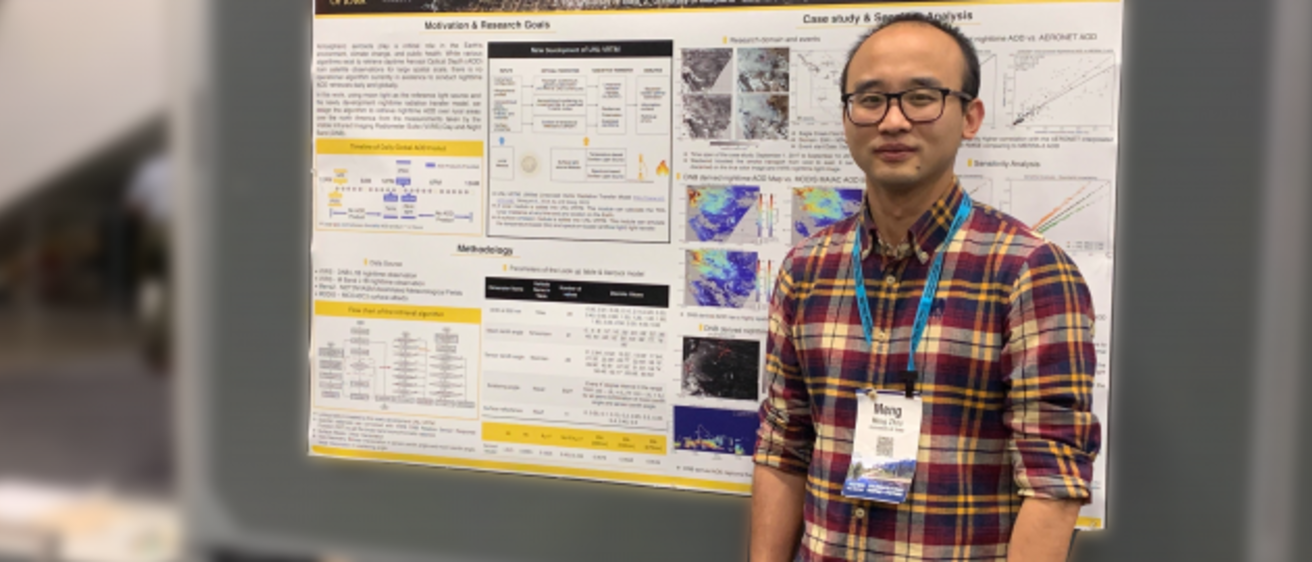An Iowa Technology Institute research assistant earned top honors for his presentation exploring the capture of aerosol data from satellite observations at night at the annual meeting of the American Meteorological Society.

Meng Zhou, a PhD student in geoinformatics and a researcher at the Atmospheric and Environmental Research Lab, placed first in oral presentations among students at the event. The winning presentation’s title was "Retrieval of Nighttime Aerosol Optical Depth Using Moonlight Measurement of VIIRS DNB."
The paper was co-authored by Zhou, Xi Chen, and Jun Wang, the James E. Ashton Professor of Engineering. Wang directs AER and is also assistant director of ITI.
The paper discusses an approach to sensing aerosols on the Earth's surface at night using the light from the moon and infrared imaging sensors aboard satellites in orbit. Currently, algorithms only retrieve aerosol data during the day.
Timely aerosol data plays a critical role in understanding the Earth's environment, climate change, and public health.
Abstract:
Atmospheric aerosols play a critical role in Earth's environment, climate change, and public health. Satellite remote sensing of aerosols is the only way for providing the daily global aerosol information and has received continuous attention and development during the past few decades. While various algorithms exist to retrieve daytime Aerosol Optical Depth (AOD) from satellite observations, there are no operational algorithms currently in existence to conduct nighttime AOD retrievals daily and globally.
By measuring visible light at night from space, the Day/Night Band (DNB) of the Visible Infrared Imaging Radiometer Suite (VIIRS) onboard respectively on the Suomi National Polar-orbiting Partnership (Suomi NPP) and National Oceanic and Atmospheric Administration 20 (NOAA-20) satellites provides the research and operational communities the capability to explore nighttime aerosol properties and thus to monitor surface air quality. Using moonlight measured by VIIRS DNB, this study retrieves the nighttime AOD for rural regions.
The radiative transfer calculation of this study is done by the UNified and Linearized Radiative Transfer Model (UNL-RTM) with newly developed capabilities for nighttime scenarios. Clouds are screened out by utilizing the observation from the Moderate Resolution Bands and DNB. Rural and city pixels are classified based on a pre-calculated city light database. Fire pixels are identified by a refined fire detection algorithm which take advantage of the nighttime visible light to detect active fire. The surface spectral reflectance for DNB ranging from 400 to 900 nm is estimated by a random forest which is trained using the surface spectral reflectance from the United States Geological Survey and from the Advanced Spaceborne Thermal Emission Reflection Radiometer spectral library.
A Gaussian process neural work is trained using the radiative transfer calculation done by the UNL-VRTM to accelerate the convolution of the look-up table and the retrieval process. We apply the algorithm to the fire season of 2017 and the FIREX-AQ Campaign 2019. DNB AOD shows good agreements with AOD measured by AERONET and CALIOP.
